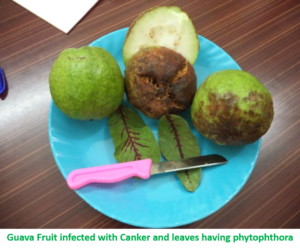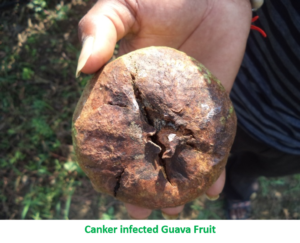< Back to Pest & Disease Management
Canker is also a common disease in guava orchards. It is caused by fungus Pestalotia psidii
Symptoms:
-
The disease generally occurs on green fruits and rarely on leaves. The first evidence of infection on fruit is the appearance of minute, brown or rust coloured, unbroken, circular, necrotic areas, which in advanced stage of infection tears open the epidermis.
-
The margin of lesion is elevated and a depressed area is noticeable inside. The crater like appearance is more noticeable on fruits than on leaves. The canker is confined to a very shallow depth and does not penetrate deep in the flesh of the fruit.
-
In older cankers, white myceliums consisting of numerous spores are noticeable. In severe cases, raised, cankerous spots develop in great numbers and the fruits break open to expose seeds.
-
The infected fruits remain underdeveloped, become hard, malformed and mummified and drop. Sometimes, small rusty brown angular spots appear on the leaves. In winter, the cankerous spots are common but in rainy season minute red specks are formed.
Mode of Spread:
The pathogen is primarily a wound parasite, thus avoid injury to fruits. Using foam net while bagging of fruits will prevent the injury to fruit.
Reason for Severity:
Germination of spores is maximum at 30C and they do not germinate below 15C or above 40C with 98% RH.
Management:
-
The spread of disease (in early stage of infection) is controlled by 3 to 4 sprays of 1 per cent Bordeaux mixture or lime sulphur at 15 days interval
- Spray Copper Hydroxide @2gms. per liter after fruit set
-
Bagging of fruits when they are ber sized (50 days after flowering)
-
Using foam net while bagging of fruits will prevent the injury to the fruit and hence canker










